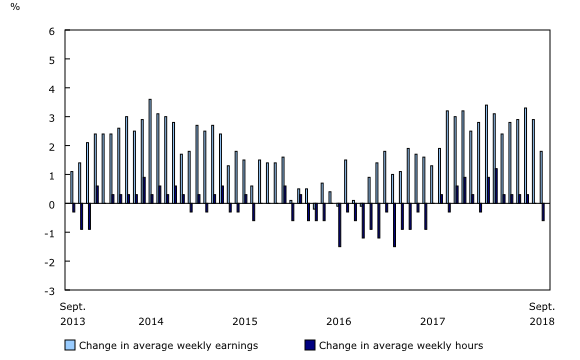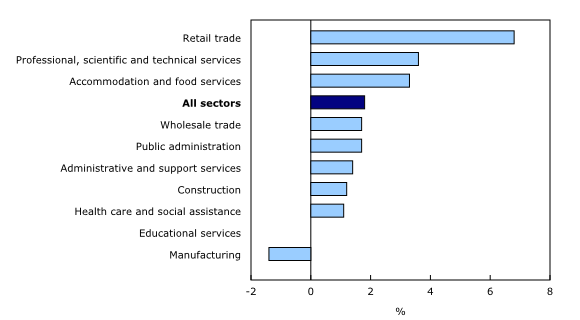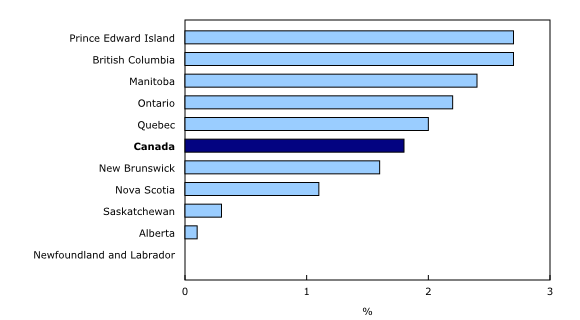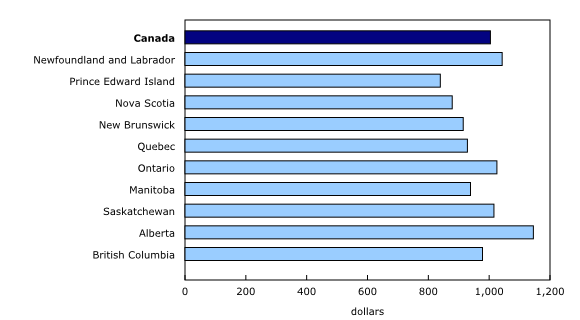Payroll employment, earnings and hours, September 2018
Archived Content
Information identified as archived is provided for reference, research or recordkeeping purposes. It is not subject to the Government of Canada Web Standards and has not been altered or updated since it was archived. Please "contact us" to request a format other than those available.
Released: 2018-11-29
$1,004.09
September 2018
1.8% 
(12-month change)
$1,042.70
September 2018
-0.0% 
(12-month change)
$839.40
September 2018
2.7% 
(12-month change)
$878.51
September 2018
1.1% 
(12-month change)
$914.66
September 2018
1.6% 
(12-month change)
$928.43
September 2018
2.0% 
(12-month change)
$1,025.45
September 2018
2.2% 
(12-month change)
$938.66
September 2018
2.4% 
(12-month change)
$1,015.72
September 2018
0.3% 
(12-month change)
$1,145.30
September 2018
0.1% 
(12-month change)
$978.10
September 2018
2.7% 
(12-month change)
$1,132.75
September 2018
2.6% 
(12-month change)
$1,428.95
September 2018
-0.8% 
(12-month change)
$1,393.77
September 2018
3.1% 
(12-month change)
Average weekly earnings of non-farm payroll employees were $1,004 in September, little changed from the previous month. Compared with 12 months earlier, earnings increased 1.8%.
In general, changes in weekly earnings reflect a number of factors, including wage growth; changes in the composition of employment by industry, occupation and level of job experience; and average hours worked per week.
Non-farm payroll employees worked an average of 32.5 hours per week in September, down from 32.8 hours in August and 32.7 hours in September 2017.
Average weekly earnings by sector
Compared with September 2017, average weekly earnings increased in 5 of the 10 largest industrial sectors, led by retail trade. At the same time, earnings decreased in manufacturing, and were little changed in administrative and support services, construction, health care and social assistance, and educational services.
In retail trade, average weekly earnings increased by 6.8% year over year to $603. The gains were spread across many subsectors, with food and beverage stores, motor vehicle and parts dealers, and general merchandise stores contributing the most to the rise. Most of the increase occurred from September 2017 to March 2018, with earnings little changed in September 2018 compared with March 2018.
For payroll employees working in professional, scientific and technical services, earnings were $1,393 in September, up 3.6% compared with September 2017. Most of the increase was the result of employment gains in the high-paying computer systems design and related services industry, as well as earnings growth in architectural, engineering and related services.
On a year-over-year basis, earnings in accommodation and food services rose 3.3% to $403, led by the full-service restaurants and limited-service eating place industry.
In wholesale trade, average weekly earnings increased by 1.7% to $1,228. Growth was mostly attributable to increases in Quebec and Ontario, but moderated by a decrease in Alberta. Nationally, the earnings increase in this sector was mostly attributable to employment gains in business-to-business electronic markets, and agents and brokers, followed by earnings gains in wholesalers of personal and household goods, and wholesalers of food, beverage and tobacco.
Payroll employees in public administration had average weekly earnings of $1,307 in September, up 1.7% from 12 months earlier. The increase was largely due to federal as well as provincial and territorial public administration, and coincided with the updating of various collective agreements.
For payroll employees in manufacturing, average weekly earnings declined 1.4% year over year to $1,090. Despite a notable increase in chemical manufacturing, declines occurred in many subsectors, with primary metal manufacturing contributing the most to the decrease. The decline in this sector was largely the result of decreases in Ontario and Newfoundland and Labrador.
Average weekly earnings by province
In the 12 months to September, average weekly earnings grew across most provinces, led by Prince Edward Island and British Columbia. At the same time, earnings were little changed in Saskatchewan, Alberta and Newfoundland and Labrador.
On a year-over-year basis, average weekly earnings grew 2.7% to $839 in Prince Edward Island, largely due to gains in administrative and support services.
Average weekly earnings increased by 2.7% to $978 in British Columbia, with most of the growth occurring from May to August. The largest gains were in construction and information and cultural industries.
Earnings in Manitoba were up 2.4% to $939. The increase was spread across several sectors, with information and cultural industries contributing the most to the growth.
For payroll employees in Ontario, average weekly earnings rose 2.2% to $1,025. Gains were spread across several sectors, with professional, scientific and technical services contributing the most.
In Quebec, earnings grew 2.0% to $928, with construction as the largest contributor. While growth was observed in many sectors, a decline in the high-paying utilities sector moderated the overall earnings increase.
Earnings in New Brunswick were up 1.6% to $915 in September, with most of the increase occurring from July to August. The largest gains were reported in public administration, retail trade and wholesale trade.
Payroll employees in Nova Scotia saw their earnings rise 1.1% to $879 in the 12 months to September. Retail trade was the largest contributor to the increase.
Non-farm payroll employment by sector
The number of non-farm payroll employees was little changed from August to September. The largest month-over-month increases were in administrative and support services, public administration, and transportation and warehousing. At the same time, payroll employment declined the most in retail trade.
Compared with September 2017, the number of payroll employees rose by 301,400 (+1.8%). Employment increased in most sectors, led by health care and social assistance (+56,200 or +2.9%), professional, scientific and technical services (+36,300 or +4.0%) and educational services (+34,100 or +2.6%). In contrast, the largest declines were in retail trade (-8,300 or -0.4%) and information and cultural industries (-6,100 or -1.8%).
Sustainable Development Goals
On January 1, 2016, the world officially began implementation of the 2030 Agenda for Sustainable Development—the United Nations' transformative plan of action that addresses urgent global challenges over the next 15 years. The plan is based on 17 specific sustainable development goals.
The Survey of Employment, Payrolls and Hours is an example of how Statistics Canada supports the reporting on the Global Goals for Sustainable Development. This release will be used in helping to measure the following goals:


Note to readers
The Survey of Employment, Payrolls and Hours (SEPH) is produced by a combination of a census of approximately one million payroll deductions provided by the Canada Revenue Agency, and the Business Payrolls Survey, which collects data from a sample of 15,000 establishments. Federal, provincial and territorial public administration data are collected from various administrative records provided by these levels of government. The key objective of the SEPH is to provide a monthly portrait of the level of earnings and the number of jobs and hours worked by detailed industry at the national, provincial and territorial levels.
Estimates of average weekly earnings and hours worked are based on a sample and are therefore subject to sampling variability. This analysis focuses on differences between estimates that are statistically significant at the 68% confidence level. Payroll employment estimates are based on a census of administrative data and are not subject to sampling variability.
Statistics Canada also produces employment estimates from its Labour Force Survey (LFS). The LFS is a monthly household survey, the main objective of which is to divide the working-age population into three mutually exclusive groups: the employed (including the self-employed), the unemployed, and those not in the labour force. This survey is the official source for the unemployment rate, and collects data on the socio-demographic characteristics of all those in the labour market.
As a result of conceptual and methodological differences, estimates of changes from the SEPH and LFS do differ from time to time. However, the trends in the data are quite similar. To better understand the conceptual differences between employment measures from the LFS and SEPH, refer to section 8 of the Guide to the Survey of Employment, Payrolls and Hours (72-203-G).
Unless otherwise stated, this release presents seasonally adjusted data, which facilitate comparisons by removing the effects of seasonal variations. For more information on seasonal adjustment, see Seasonally adjusted data – Frequently asked questions.
Non-farm payroll employment data are for all hourly and salaried employees, as well as for the "other employees" category, which includes piece-rate and commission-only employees.
Unless otherwise specified, average weekly hours data are for hourly and salaried employees only and exclude businesses that could not be classified to a North American Industry Classification System (NAICS) code.
All earnings data include overtime pay and exclude businesses that could not be classified to a NAICS code. Earnings data are based on gross taxable payroll before source deductions. Average weekly earnings are derived by dividing total weekly earnings by the number of employees.
With each release, data for the current reference month are subject to revision. Data have been revised for the previous month. Users are encouraged to request and use the most up-to-date data for each month.
Real-time data tables
Real-time tables 14-10-0357-01, 14-10-0358-01, 14-10-0331-01 and 14-10-0332-01 will be updated on December 10.
Next release
Data on payroll employment, earnings and hours for October will be released on December 20.
Products
Job Vacancy Statistics (5202) from the Survey of Employment, Payrolls and Hours for August are now available.
More information about the concepts and use of the Survey of Employment, Payrolls and Hours and Job Vacancy Statistics is available in the Guide to the Survey of Employment, Payrolls and Hours (72-203-G).
Contact information
For more information, contact us (toll-free: 1-800-263-1136; 514-283-8300; STATCAN.infostats-infostats.STATCAN@canada.ca).
To enquire about the concepts, methods or data quality of this release, contact Rachelle Pelletier (613-415-4867; rachelle.pelletier@canada.ca) or Client Services (toll-free: 1-866-873-8788; statcan.labour-travail.statcan@canada.ca), Labour Statistics Division.
- Date modified:





